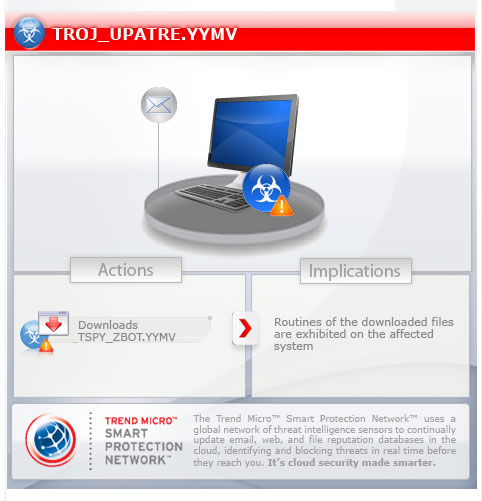TROJ_UPATRE.YYMV
Troj/DwnLdr-LPP (Sophos) ,Trojan horse Generic10_c.CKBE (AVG) ,W32/Zbot.TAZF!tr (Fortinet) ,W32/Trojan3.IMF (exact) (Fprot) ,Trojan.Crypt (Ikarus) ,Trojan-Spy.Win32.Zbot.tazf (Kaspersky) ,TrojanDownloader:Win32/Upatre (Microsoft) ,Generic.sq (McAfee) ,Win32/TrojanDownloader.Waski.D trojan (Eset) ,Downloader.Upatre (Symantec) ,Trojan.Win32.Generic.pak!cobra (Sunbelt)
Windows 2000, Windows Server 2003, Windows XP (32-bit, 64-bit), Windows Vista (32-bit, 64-bit), Windows 7 (32-bit, 64-bit)


Threat Type: Trojan
Destructiveness: No
Encrypted:
In the wild: Yes
OVERVIEW
This malware was used in a spam campaign that uses Dropbox as a social engineering lure in order for users to click the related links.
To get a one-glance comprehensive view of the behavior of this Trojan, refer to the Threat Diagram shown below.

This Trojan arrives as an attachment to email messages mass-mailed by other malware/grayware or malicious users.
It executes the downloaded files. As a result, malicious routines of the downloaded files are exhibited on the affected system.
It deletes itself after execution.
TECHNICAL DETAILS
Arrival Details
This Trojan arrives as an attachment to email messages mass-mailed by other malware/grayware or malicious users.
Installation
This Trojan drops the following copies of itself into the affected system and executes them:
- %User Temp%\pdfmarks.exe
(Note: %User Temp% is the current user's Temp folder, which is usually C:\Documents and Settings\{user name}\Local Settings\Temp on Windows 2000, XP, and Server 2003, or C:\Users\{user name}\AppData\Local\Temp on Windows Vista, 7, and 8.)
Download Routine
This Trojan connects to the following website(s) to download and execute a malicious file:
- https://{BLOCKED}ping-myrtle-beach.com/wp-content/uploads/2014/05/2805UKdw.dkt
It saves the files it downloads using the following names:
- %User Temp%\yaccpdf.exe - detected as TSPY_ZBOT.YYMV
(Note: %User Temp% is the current user's Temp folder, which is usually C:\Documents and Settings\{user name}\Local Settings\Temp on Windows 2000, XP, and Server 2003, or C:\Users\{user name}\AppData\Local\Temp on Windows Vista, 7, and 8.)
It then executes the downloaded files. As a result, malicious routines of the downloaded files are exhibited on the affected system.
Other Details
This Trojan deletes itself after execution.
SOLUTION
Step 1
Before doing any scans, Windows 7, Windows 8, Windows 8.1, and Windows 10 users must disable System Restore to allow full scanning of their computers.
Step 2
Remove the malware/grayware file dropped/downloaded by TROJ_UPATRE.YYMV. (Note: Please skip this step if the threat(s) listed below have already been removed.)
Step 3
Identify and terminate files detected as TROJ_UPATRE.YYMV
- Windows Task Manager may not display all running processes. In this case, please use a third-party process viewer, preferably Process Explorer, to terminate the malware/grayware/spyware file. You may download the said tool here.
- If the detected file is displayed in either Windows Task Manager or Process Explorer but you cannot delete it, restart your computer in safe mode. To do this, refer to this link for the complete steps.
- If the detected file is not displayed in either Windows Task Manager or Process Explorer, continue doing the next steps.
Step 4
Scan your computer with your Trend Micro product to delete files detected as TROJ_UPATRE.YYMV. If the detected files have already been cleaned, deleted, or quarantined by your Trend Micro product, no further step is required. You may opt to simply delete the quarantined files. Please check the following Trend Micro Support pages for more information:
Did this description help? Tell us how we did.

